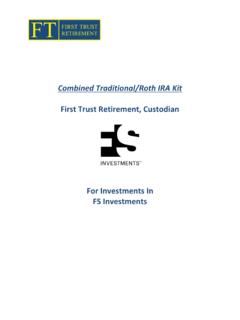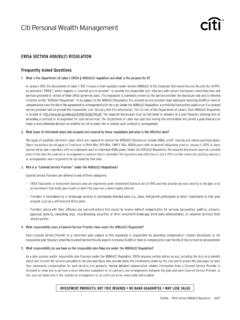Transcription of In-Service Distributions: Retirement Plan Rollovers to ...
1 In-Service Distributions: Retirement plan Rollovers to iras Made While You Continue to Work for Your EmployerIn-Service Distributions: Background Most people know that when they leave their current employer, they can roll over Retirement plan assets to an IRA and, potentially, to a Retirement plan with a new employer. The In-Service distribution option is less well known. It allows you to roll over assets from your current employer s qualified Retirement plan to an IRA while you are still working for that employer, assuming your plan permits it and you otherwise qualify for the In-Service distribution . In-Service distributions are available for certain defined contribution plans, such as 401(k)s, 403(b)s, 457 and other plans as well as for defined benefit and other qualified plans. Typically, for an In-Service distribution , transferring the whole account balance is not permitted.
2 However, depending on the plan s rules, you may be able to roll over a significant percentage of the vested balance of the Retirement plan to an IRA. It is important to check with your plan administrator or review your plan documents to make certain that a distribution will not affect your ability to contribute to your employer-sponsored plan or cause any problems with vesting. Each plan is different, and there may be rules specific to your employer s plan . Note that an In-Service distribution is different from a hardship distribution , which requires the employee to meet certain requirements for the money to be spent for specific uses only. While employees can typically take some or all of their 401(k) money out for any purpose they choose, by rolling over the assets to an IRA, you can typically avoid paying federal (and possibly state) income tax and penalties on the distribution BenefitsWhy would an individual choose to implement an In-Service distribution from a 401(k) or other qualified Retirement plan ?
3 There are several potential benefits: Investment Choice Often, iras provide a wider array of investment choices than certain 401(k) or other Retirement plans do offering diversification benefits. Certain employer-sponsored plans may limit investment choices to a range of mutual funds, while an IRA can permit you to invest in individual stocks, bonds, separately managed accounts, ETFs, mutual funds and a number of other choices. Control and Flexibility Individuals may have an interest in taking greater control of the options offered by their plans. In addition to investment selection, cost containment potential, administration and custodial decisions may be more flexible with an individuals have assets invested in an employer-sponsored Retirement plan such as a 401(k), 403(b) or other type of qualified plan .
4 If your employer s plan permits it, an In-Service distribution can allow you to withdraw some of the vested assets in the plan and roll them over to an IRA while you are still working for the employer sponsoring your Arch Street, Philadelphia, PA | | | Member NYSE FINRA SIPCwww. 2012 janney montgomery Scott LLc member: nySe, FInra, SIPc reF. 128414 In-Service dIStrIbutIonS From Retirement PLanS Page 1www. 2012 janney montgomery Scott LLc member: nySe, FInra, SIPc reF. 128414 In-Service dIStrIbutIonS From Retirement PLanS Page 2As noted above, cost containment or fee levels may be a reason for the choice to initiate an In-Service distribution . Under the new ERISA rules 408(b)(2) and 404(a)(5), effective on 7/1/2012 and 8/30/2012 respectively, plan participants will receive full disclosure of all fees associated with their 401(k) and 403(b) plans, including direct and indirect compensation as well as specification of services and status.
5 Once individuals review these fees, they may wish to consider taking In-Service distributions, assuming their present plan documents allow for the RulesJust because IRS regulations allow for an employee to take an In-Service distribution , this does not necessarily mean that the employer s qualified plan rules will allow it. There is no requirement for an employer-sponsored Retirement plan to permit In-Service distributions. You can check with your Human Resources Department or Retirement plan administrator to determine if In-Service distributions are permitted in your specific plan and under what terms they are offered. Other ConsiderationsThere are several other considerations you can contemplate prior to taking an In-Service distribution from a qualified Retirement plan . They include: Age In qualified plans, the age-55 rule allows participants who stop working at age 55 or older to take distributions without having to endure the 10% IRS premature distribution penalty.
6 In an IRA, investors may not take distributions until they reach the age of 59 unless the distributions qualify as a series of substantially equal periodic payments . In order to meet the qualifications under Section 72(t) of the Internal Revenue Code, these payments must continue for five years or until the individual reaches age 59 whichever period is longer. There are some limitations as to how iras may be structured under 72(t). Therefore, if you plan to retire early, you may wish to consider preserving access to your Retirement funds by not moving all of your 401(k) assets to an IRA before Retirement . Net Unrealized Appreciation (NUA) Net Unrealized Appreciation (NUA) tax treatment is not an option for distributions from iras . Therefore, if an individual holds highly appreciated company stock in his or her current employer-sponsored plan , rolling over that stock to an IRA eliminates any ability they may have to take advantage of NUA tax treatment prior to Retirement .
7 Creditor Protection While iras now have federal bankruptcy protection, other IRA creditor protection is still determined by state laws. Assets of qualified plans such as 401(k) and 403(b) plans continue to have broad federal creditor protection. Therefore, shifting assets to an IRA through an In-Service distribution may limit your ability to shield assets from some creditors. New Contributions to Existing Plans As noted, while there typically are no restrictions after taking In-Service distributions, it is important to check with your plan administrator to make certain that a distribution will not affect your ability to contribute to your employer-sponsored plan or cause problems with regard to vesting. Each plan is different, and there may be rules specific to your employer s plan .
8 Required Minimum Distributions If you have reached age 70 , are still working and participating in your employer s qualified plan , you can often defer the Required Minimum Distributions (RMDs) until April 1 of the year following the year you officially retire. Comparatively, in an IRA, RMDs must begin by April 1 of the year following the year the owner turns 70 . Note that some plans may have mandatory distributions at age 70 that are specific to the plan , rather than following the rules defined by the Internal Revenue Code. This may be especially true for a business in which you have more than 5% ownership. In-Service Distributions May Lead to Cost Increases for Remaining Participants One 1717 Arch Street, Philadelphia, PA | | | Member NYSE FINRA SIPCwww. 2012 janney montgomery Scott LLc member: nySe, FInra, SIPc reF.
9 128414 In-Service dIStrIbutIonS From Retirement PLanS Page 3impact worth mentioning is that if enough older employees (who probably comprise the majority of the assets of the plan ) elect to take In-Service distributions, the level of plan assets and pricing may be impacted and potentially raise the costs to the remaining participants of the Simple Steps to Taking ActionThere are three simple steps to completing an In-Service distribution . They are:1. Determine your eligibility under your plan s document and any limitations that may result if you take an In-Service distribution . Some plans may have placed specific limitations on these distributions or restrict In-Service distributions Establish a rollover IRA to receive the assets you plan to roll Complete the rollover, working with your plan administrator and the firm at which your IRA is qualified plans offer many important benefits, there is additional interest in In-Service distributions at this time.
10 In-Service distributions may offer the potential for increased diversification and more control over your Retirement plan assets and features. However, it is important to determine if your plan permits such distributions, and whether any future restrictions would result if you take such a distribution (limitations on future contributions or vesting). By reviewing your qualified plan document and speaking with your plan administrator or Human Resources Department, you can learn is also helpful to review the considerations detailed earlier in this publication to ensure this strategy makes sense for your personal situation. Your Janney Financial Advisor and our Wealth Planning specialists can help you to determine if an In-Service distribution makes sense. Janney Montgomery Scott LLC, its affiliates, and its employees are not in the business of providing tax, regulatory, accounting or legal advice.






